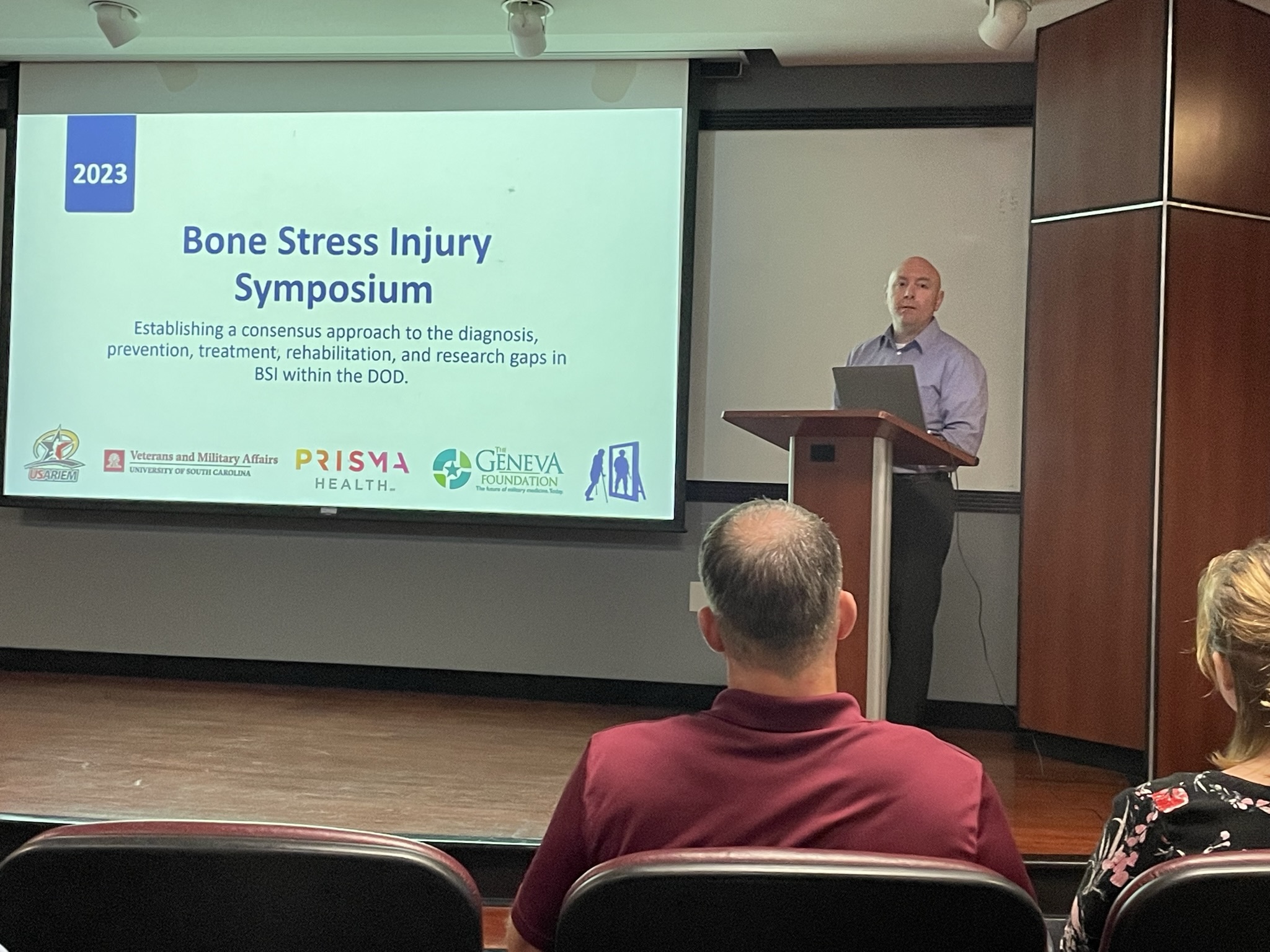25 September 2023
Inaugural Bone Stress Injury Symposium
In a clear demonstration of its commitment to enhancing the readiness and well-being of our nation’s military, the Musculoskeletal Injury Rehabilitation Research for Operational Readiness (MIRROR) program, in collaboration with esteemed partners including the U.S. Army Research Institute of Environmental Medicine (USARIEM), Prisma Health, and Moncrief Army Health Clinic, jointly sponsored the inaugural Department of Defense-wide Bone Stress Injury (BSI) Symposium.
Held on June 8-9, 2023, at the University of South Carolina and presented by Fort Jackson, this event marked a significant milestone, bringing together over 130 participants, both in-person and virtually. This two-day symposium united a consortium of professionals, encompassing military leaders, university professors, clinicians, advocates, and thought leaders from across the nation, committed to comprehensively addressing the challenge of stress fractures in the military.
The Critical Impact of Bone Stress Injuries
Bone stress injuries (BSI) present a substantial threat to military personnel, particularly new recruits. During basic training, when physical demands escalate sharply, trainees may encounter these injuries. The abrupt intensification of repetitive physical activity during this phase, often involving the use of heavy gear such as body armor and rucksacks, places recruits at a pronounced risk. Such injuries can have enduring consequences, potentially necessitating trainees to undergo retraining or even leading to their separation from military service. Furthermore, these injuries may contribute to future joint and mobility issues, thus impacting long-term military readiness. The imperative to address these injuries cannot be overstated, as it profoundly affects the health and readiness of our service members.
Mission and Approach of the BSI Symposium
The BSI Symposium is driven by a crucial mission to bolster soldiers’ bone health while directly addressing the threat of BSI to military readiness. The mission is intricately tied to the operational and command components, ensuring alignment with the needs of regional and local commands. It aims to forge a diverse coalition of expert partners, combining their collective knowledge and experience. Additionally, the symposium is committed to securing the essential leadership, physical infrastructure, and resources imperative for achieving these vital goals. This approach ensures that the mission remains firmly grounded in practical operational considerations, avoiding detachment from the real-world needs of our military personnel.
Major Gary L. Helton, the driving force behind this symposium, articulated its success with these words: “At this inaugural symposium, the level of success exceeded even our most optimistic projections. It stands out as the most productive conference I’ve had the privilege of attending, distinguished by its unprecedented collaboration across diverse disciplines, all focused on addressing a highly specific issue critical to our nation’s readiness. The symposium created substantial momentum for forthcoming endeavors aimed at enhancing our capabilities in diagnosing, treating, and preventing bone stress injuries. Nevertheless, this event marks only the initial step in our ongoing commitment to the well-being of our future generation of soldiers.”
Insights, Innovations, and Empowerment
The first day of the symposium featured enlightening sessions and presentations on various topics, including the impact of NSAIDs on BSI, the role of biomarkers, wearables, bone scanning, and musculoskeletal injury studies.
The second day continued with discussions on various topics, such as the intersection of H2F and TOMS, Fort Jackson’s holistic health and fitness approach, and an introduction to the Bone Strength Center. Notably, Dr. Brad Isaacson, Chief of Research & Operations for MIRROR and Geneva Principal Investigator, delivered a highly regarded virtual presentation providing an overview of MIRROR’s work. He also shed light on the Photomedicine Collaboration and the BSI-related study titled “Utilizing Photobiomodulation Therapy for the Treatment of Lower Extremity Stress Fractures in a Military Training Setting.” This study holds promise in investigating the efficacy of supplementing the treatment of tibial and metatarsal stress fractures with photobiomodulation therapy.
The symposium culminated with a BSI SWOT analysis discussion featuring subject matter experts and closing remarks by Brigadier General Jason E. Kelly, emphasizing the importance of these discussions in addressing the issue of BSI.
A Promising Future Ahead
As we eagerly anticipate the next BSI Symposium, the collaborative spirit, wealth of knowledge, and unwavering determination cultivated here promise a brighter, more resilient future for our military, fortified against the threat of bone stress injuries.
Disclaimer: The views expressed do not reflect the official policy of the Army, the Department of Defense, or the U.S. Government.

"At this inaugural symposium, the level of success exceeded even our most optimistic projections. It stands out as the most productive conference I’ve had the privilege of attending, distinguished by its unprecedented collaboration across diverse disciplines, all focused on addressing a highly specific issue critical to our nation’s readiness."
Major Gary L. Helton
HIGHLIGHTS
- Over 130 experts gathered virtually and in-person on June 8-9, 2023, addressing bone stress injuries in the military.
- Trainees face stress fractures during basic training, posing a threat to long-term readiness.
- Dr. Brad Isaacson's presentation on Photobiomodulation Therapy offers a promising approach to treating lower extremity stress fractures.


